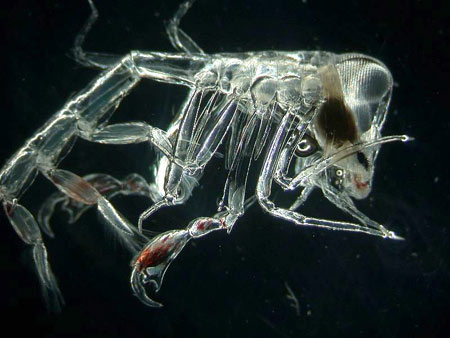Life cycle that may have influenced that of the Xenomorph
It has recently been suggested that Phronima was the inspiration behind the Xenomorph:

From the Wikipedia article concerning Phronima:
Although commonly known as parasites, they are more technically correctly called parasitoids. Instead of constantly feeding on a live host, females attack salps, using their mouths and claws to eat the animal and hollow out its gelatinous shell. Phronima females then enter the barrel and lay their eggs inside, and then propels the barrel through the water as the larvae develop...
If the articles above are correct and Phronima is indeed the inspiration behind the Xenomorph, then it is easy to see how one might extrapolate the Xenomorph's life cycle from Phronima's.
Life cycle that is more like that of the Xenomorph
However, Phronima's life cycle is not exactly that of the Xenomorph. For an animal using intermediate offspring to reproduce, I would nominate Cnidaria, which @Hypnosifl has already mentioned prior to my answer. Cnidaria includes jellyfish and the common sea nettle. A group of the latter is pictured below:

Here is a pictorial representation of their life cycle:

Steps 4-8 show the growth and release of the "polyp", an intermedia offspring which will give rise to the "medusa", which is the full animal.
In regards to plant species, ferns are a good example of a plant that uses an intermediate offspring to reproduce.
Another interesting Alien-esque life cycle in nature
May I present to you Dicrocoelium Dentriticum, better known as the Lancet Liver Fluke, a.k.a. "Captain Higgins":
- Its eggs are defecated by a cow or horse, etc.
- The eggs are eaten by snails, where they hatch into larvae
- The larvae mature to juvenile stage within the snail
- As a reaction, the snail grows a cyst to surround the juveniles, and then the parasite-filled cyst is ejected by the snail
- The juvenile flukes are in an egg again, but they used the snail to create it for them
- The cyst-egg is consumed by an ant, where it breaks open
- The juveniles flow and/or burrow up to the ant's brain and latch onto it causing the ant to climb a blade of grass each evening until the blade of grass (and the ant and the juvenile flukes) are consumed by a cow or horse
- Inside the cow or horse, they mature into adults and lay eggs
- Poo, repeat

Again, not quite the life cycle of the Xenomorph, but there is a two-stage process here that involves at least three animals being seeded along the way.
Upshot
Various life cycles in nature — e.g. Phronima, Cnidaria, Ferns, Lancet Liver Flukes — have features in common with that of the Xenomorph. However, the facehugger, which is a wholly separate lifeform that lays its own egg via a proboscis into a host, seems to be unique to the Xenomorph. I can find no evidence for it in the "real world".
In a sense, the only thing that comes closeclosest is common bisexual animal reproduction. The only caveat is that sperm don't lay their own eggs!





